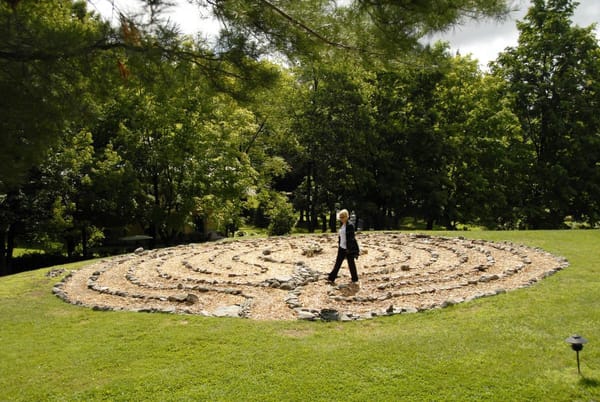Find Your Center In A Local Labyrinth
A labyrinth only requires you to put one foot in front of the other and almost guarantees a quieter mind.

A labyrinth only requires you to put one foot in front of the other and almost guarantees a quieter mind.

Photo courtesy Omega Institute
Mazes are made to confuse you and lose you down many paths. A labyrinth is built with one meandering, spiraling path designed to draw you methodically to the center — the center of the design and the center of yourself. These circular walking patterns, which originated in ancient Greece but were later adopted as Christian and Eastern meditative practices, are characterized by the Labyrinth Guild as a “three-fold path. Upon entering, one begins the symbolic path of purgation, or releasing and letting go. The center represents illumination and opening to the divine (and) the return path is union, taking the walk’s benefits back into our lives.”
All of the local labyrinths, whether built by a Christian church, yoga center or a group of old college chums, were designed thoughtfully to help pull one away from external stresses and focus inward. Though they may be crafted with different motivations, there is no denying that the act of slowly and deliberately walking any of them is effective at helping to peel away some of the layers of our outward-facing selves, even if for just a moment. For your consideration, we've compiled a list of some of our local labyrinths. It should be noted that some of these are on facilities that may be closed at times, so follow the links to check times and availability.

Photo courtesy Wisdom House Retreat and Conference Center
Wisdom House Retreat and Conference Center, Litchfield, Connecticut. The labyrinth at this interfaith retreat center comes from the traditions of the Daughters of Wisdom, who still live and worship here. Continuing in the tradition of Saint Louis de Montfort and Blessed Marie Louise Trichet, the aim of the congregation is to seek Divine Wisdom, and the labyrinth is used in the pursuit. Now open to worshipers of all faiths, the labyrinth, made of alternating rings of stone and brick, expands its usefulness.
Omega Institute For Holistic Studies, Rhinebeck, New York. Omega’s labyrinth is a great example of the lasting beauty of a simply constructed pattern made of field rocks and following the traditional seven circuit design. The labyrinth was made in 1987 by an earthworks class led by Paul Devereux — author, lecturer and researcher of “archaeoacoustics” (the study of sound at ancient places) — and each member selected a potential site independently. According to Devereux, 70 percent of the class chose the same location.
St. James Church, Hyde Park, New York. The labyrinth is used with some frequency in the Catholic church. The meditative intention of walking a labyrinth in a religious context puts emphasis on prayer, but the language used to describe the experience is often surprisingly similar to the more Eastern-based meditation practices. The labyrinth at St. James is nestled beside the church’s small cemetery. Inlaid into the grass, it’s a powerful place for reflection. If you’re new to the labyrinth experience, the St. James website offers a terrific guide to help you get the most out of your walk.
Our Lady Of Hope RC Church, Copake Falls, New York. Like at St. James, the labyrinth here is inlaid in the grass behind the church. The peaceful spot is surrounded by an old stone wall that opens onto a bucolic field beyond. It is hard not to feel somewhat transported by the unmistakable influence of the church’s Irish lineage. There’s an interesting, incidental synergy between the traditional design of the labyrinth and Celtic knots common in church iconography.
Philmont Village Park, Philmont, New York. The labyrinth in the Philmont Village Park was built by old friends from Emerson College looking to mark their 14th anniversary gathering with an element of community service. In partnership with the local Walking the Dog Theater Company, the group used one of the oldest-known labyrinth designs in the Christian context, from Chartres Cathedral outside Paris, which some in the group had visited. This design is recognizable by its central flower. The mosaic-style labyrinth in the village grass echoes the way the design is inlaid on the floor of the French cathedral.
Unitarian Universalist Fellowship of Poughkeepsie “The journey of the Labyrinth is a metaphor for life’s journeys. Feel free to find your own use for such a journey,” states this organization’s website. This labyrinth was an expansion of its spiritual space and as a service to the community at large. It’s open to the public daily from dawn to dusk, except for Sunday mornings during services.